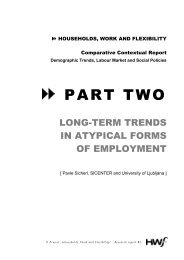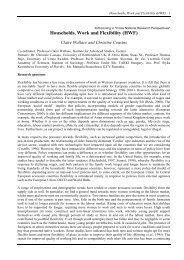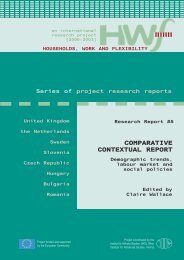Guidelines for Analysis of Surveys - HWF
Guidelines for Analysis of Surveys - HWF
Guidelines for Analysis of Surveys - HWF
Create successful ePaper yourself
Turn your PDF publications into a flip-book with our unique Google optimized e-Paper software.
<strong>HWF</strong> <strong>Guidelines</strong> <strong>for</strong> national Survey Reports 2<br />
Headings <strong>for</strong> <strong>Analysis</strong><br />
1. Patterns <strong>of</strong> time flexibility<br />
Different hours <strong>of</strong> work according to sex, age and social group (social class but also<br />
urban/rural) and economic standard <strong>of</strong> the household overall (which would need to be<br />
calculated in each country) and the economic level <strong>of</strong> the individual.<br />
Each country needs to define what they mean by flexibility and how it was defined in<br />
the data set.<br />
(1.10-1.19, Grid 1)<br />
2. Patterns <strong>of</strong> place flexibility<br />
Different places <strong>of</strong> work according to sex, age and social group (social class but also<br />
urban/rural) and economic standard <strong>of</strong> the household overall and the economic level<br />
<strong>of</strong> the individual.<br />
(1.20-1.24, Grid 1)<br />
3. Patterns <strong>of</strong> flexibility <strong>of</strong> conditions<br />
Different condition <strong>of</strong> work according to sex, age and social group (social class but<br />
also urban/rural) and economic standard <strong>of</strong> the household overall and the economic<br />
level <strong>of</strong> the individual.<br />
(1.25-1.29, Grid 1)<br />
4. Patterns <strong>of</strong> career flexibility<br />
How flexible are respondents across their careers? According to age, social class,<br />
education and economic standard <strong>of</strong> the household overall and the economic level <strong>of</strong><br />
the individual.<br />
(4.3-4.5)<br />
5. The Accumulation <strong>of</strong> different kinds <strong>of</strong> work<br />
How individuals put together a range <strong>of</strong> different kinds <strong>of</strong> work according to sex, age,<br />
social group and economic standard <strong>of</strong> the household and the individual<br />
(1.5,1.6,1.7,Grid 1)<br />
6. Perceptions <strong>of</strong> flexibility<br />
According to sex, age and social group and economic standard <strong>of</strong> the household and<br />
individual<br />
(4.1-4.2)<br />
7. Integration <strong>of</strong> home and work<br />
Different patterns <strong>of</strong> family and work according to age, social group, household<br />
membership. (Perhaps create typologies <strong>of</strong> family and work).<br />
(Grid 2,Grid 3)









